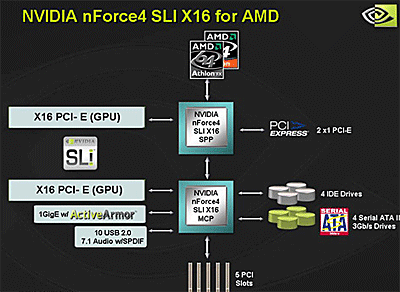ASUS A8N32 SLI Deluxe - nForce 4 SLI X16 Unleashed
The A8N32 SLI Deluxe - Up Close

The chipset that the A8N32 SLI Deluxe is built around is essentially a beefed-up version of the already beefy NVIDIA nForce4 SLI for the AMD platform.

In this version of the chipset, NVIDIA expanded PCI Express connectivity to a total of 32 lanes specifically dedicated to graphics for full support of two X16 PCI Express Graphics cards in SLI mode. No longer must the cards split a single X16 connection into a pair of X8 electrical connections in each slot. Now each PEG slot is fully connected with an X16 link to the root complex, in this case what is pictured as the "SPP" or System Platform Processor in the block diagram above. This is what can be classically thought of as the northbridge of the chipset, while the NVIDIA "MCP" or Media Communications Processor pictured above handles the I/O and Storage connectivity, for support of Serial ATA drives also in RAID 0, 1, 0+1 and 5 configurations, as well as USB2.0, Firewire, Gig-E, and NVIDIA ActiveArmor Secure Networking and Firewall features. Below is a table that details all of the various incarnations of the entire nForce 4 family, for your reference.
| Feature | nForce4 SLI X16 | nForce4 SLI |
nForce4 Ultra |
nForce4 |
| Platform Support | Intel & AMD | Intel & AMD | AMD | AMD |
| CPU | Intel P4 Socket 775 or AMD Athlon 64 FX/ Athlon 64 |
Intel P4 Socket 775 or AMD Athlon 64 FX/ Athlon 64 |
Athlon 64 FX Athlon 64 Sempron |
Athlon 64 FX Athlon 64 Sempron |
| PCI Express # Lanes/ Configuration | Intel: 40 Lanes Flexible AMD: 38 Lanes Flexible |
20 lanes Flexible |
20 lanes Fixed (16,1,1,1) |
20 lanes Fixed (16,1,1,1) |
| NVIDIA SLI™ Dual GPU Support | Yes x16 |
Yes x8 |
—
|
—
|
| SATA Drive Support |
4 (3Gb/s)
|
4 (3Gb/s)
|
4 (3Gb/s)
|
4 (1.5Gb/s)
|
| PATA Drive Support |
4
|
4
|
4
|
4
|
| MediaShield™ Storage |
Yes
|
Yes
|
Yes
|
Yes
|
| RAID 5 (bootable) |
Yes
|
Yes
|
—
|
—
|
| RAID Morphing |
Yes
|
Yes
|
Yes
|
Yes
|
| ActiveArmor™ Secure Networking Engine |
Yes
|
Yes
|
Yes
|
—
|
| ActiveArmor™ Firewall |
Yes
|
Yes
|
Yes
|
Yes
|
| Native Gigabit Ethernet |
Yes
|
Yes
|
Yes
|
Yes
|
| nTune™ Utility |
Yes
|
Yes
|
Yes
|
Yes
|
|
The A8N32 SLI Deluxe board itself is an impressive assembly of technology to behold. Chipset cooling on the board is a totally passive solution, employing the company's heat pipe technology along with its "Stack Cool" fanless design to cool both the SPP and MCP as well as the CPU power array. ASUS also offers "optional" cooling fans that clip on top of the power array heatsink fin assembly, but this is not a requirement for normal operation or even overclocking conditions with air cooling for the CPU. Rather, ASUS recommends the use of these fans in extreme cases where watercooling or some other air-free method of cooling, such as Vapor Phase Change, is used.
ASUS also built the A8N32 with an eight-phase power MOSFET power module array. ASUS claims their eight-phase or eight stage power array provides a cleaner, more ripple free signal to the CPU that also has the ability to react more quickly to voltage and current transient demands as heavy loads are placed upon the CPU.
However, the location of two of the board's standard PCI slots make it a very tight squeeze for anyone who actually runs this board with a Dual Graphics SLI setup. And isn't that the whole intent of the product, with its extra X16 PCIe connection? If you would actually like to use those two PCI slots for expansion, say a TV-Tuner card or something of that nature, air flow between the PCIe Graphics slots will be very restricted. In addition, with any dual-slot cooled graphics card (ASUS' own N7800 GTX Top for example), you'll be limited to a single half-height PCI card in between the PEG slots, and the end PCI slot on the board is also completely obstructed, as well. We were left wondering what the physical layout limitation may have been that caused ASUS to drop not one but two PCI slots in between the PEG slots, when perhaps they could have been placed at the end of the line where they could be more easily accessed and utilized.





















